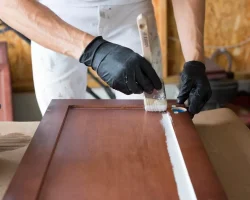
The Best Type Of Sandpaper To Use For Prepping A Paint Job
Whether you’re a beginner or a seasoned woodworker, sanding can be a bit of a chore. But with a few tips and tricks, you can make the process go more smoothly and get better results.
Choose the right sandpaper
There are a variety of sandpaper types available, and each has its own strengths and weaknesses. For most projects, you’ll want to use either aluminum oxide or silicon carbide sandpaper.
Aluminum oxide is the most common type of sandpaper and will work for most projects. It’s durable and long-lasting, and it can be used on a variety of materials.
Silicon carbide is a good choice for sanding hardwoods, as it’s very sharp and will remove material quickly. However, it can also clog up quickly, so you’ll need to clean it frequently.
Start with a coarse grit
When you start sanding, it’s important to use a coarse grit sandpaper. This will remove the majority of the material quickly and help to level out the surface.
Once you’ve removed the majority of the material, you can switch to a finer grit sandpaper to smooth out the surface.
Use even pressure
When sanding, it’s important to use even pressure. This will help to avoid creating gouges or uneven surfaces.
Use a sanding block
A sanding block can help to evenly distribute the pressure you’re putting on the sandpaper and will also help to avoid creating gouges.
Clean the surface regularly
As you sand, the surface will start to clog up with debris. This can dull the sandpaper and make it less effective.
To avoid this, it’s important to clean the surface regularly. A simple way to do this is to use a vacuum cleaner with the hose attachment.
Finish with a fine grit
Once you’ve removed the majority of the material, you can switch to a finer grit sandpaper to smooth out the surface.
For most projects, you’ll want to finish with a grit between 220 and 320.
Apply a finish
Once you’ve finished sanding, it’s important to apply a finish to the surface. This will help to protect it from damage and keep it looking its best.
There are a variety of finishes available, and the best one for your project will depend on the type of wood and the desired look.
A few common finishes include lacquer, polyurethane, and Danish oil.
Sand with the grain
When sanding, it’s important to sand with the grain of the wood. This will help to avoid damage and create a smoother surface.
Use a dust mask
When sanding, it’s important to wear a dust mask to avoid inhaling the fine particles.
Take your time
Sanding can be a bit of a tedious task, but it’s important to take your time and do it right.
If you rush the process, you’ll likely end up with an inferior finish and a surface that’s more likely to be damaged.
